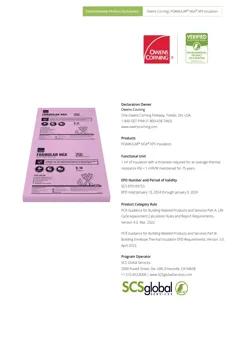

Other manufacturers with similar products
EPD: Sheathing laminate add-on for insulation, 2438 mm x 610 mm, 28.8 mm, 2.91E-2 kg/m2, 13.56 kg/m3, FOAMULAR® NGX® - 150, 250, 350, 400/600/100, 404/604, 404RB/604RB, LT30/LT40, CW25, THERMAPINK® 25, INSUL-DRAIN, Fanfold, AgTek, PINKCORE, EDGELOCK®, C-200, C-300, CodeBord, Insulating Sheathing, Half-inch, Owens Corning
Enhance your home's energy efficiency and comfort with high-performance fiberglass insulation. Easy to install, it offers superior thermal and acoustic properties, contributing to lower energy bills and a quieter indoor environment.
Flexible fiberglass insulation batts designed to fit between framing members in walls, ceilings, and floors, enhancing thermal performance and sound control. Available unfaced or with vapor-retarder facings; easy to cut and install.
Install between studs, joists, or ra...
Manufacturer:
Owens Corning
Group:
Country of production:
Product name:
Sheathing laminate add-on for insulation
Commercial names:
FOAMULAR® NGX® - 150, 250, 350, 400/600/100, 404/604, 404RB/604RB, LT30/LT40, CW25, THERMAPINK® 25, INSUL-DRAIN, Fanfold, AgTek, PINKCORE, EDGELOCK®, C-200, C-300, CodeBord, Insulating Sheathing, Half-inch
Category:
Insulation
Class:
XPS (extruded polystyrene) insulation
Type:
XPS
Environmental impacts
Global Warming Potential (A1-A3):
0.187 kg CO2e/m²
Technical specification:
2438 mm x 610 mm, 28.8 mm, 2.91E-2 kg/m², 13.56 kg/m³
Available units for calculation:
m², kg, ton, m³
Unique identifier (OCLID):
66139bc229543942516fab44
Sustainability data background information
EPD number:
SCS-EPD-09753
EPD program:
SCS Global
Publication year:
2024
Product Category Rules (PCR):
PCR for Part B: Building Envelope Thermal Insulation EPD Requirements. Version 3.0. April 2023
Environmental standard:
ISO 14040
Data source:
EPD Owens Corning| FOAMULAR® NGX® XPS Insulation
Verification status:
Third-party verified (as per ISO 14025)
Upstream database:
ecoinvent


